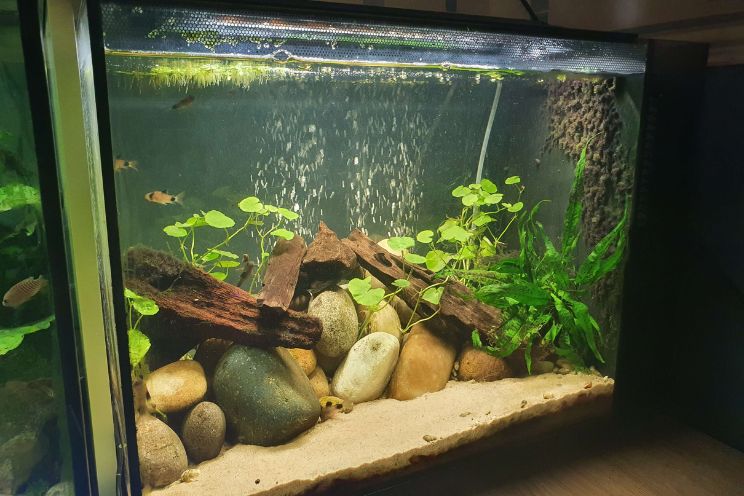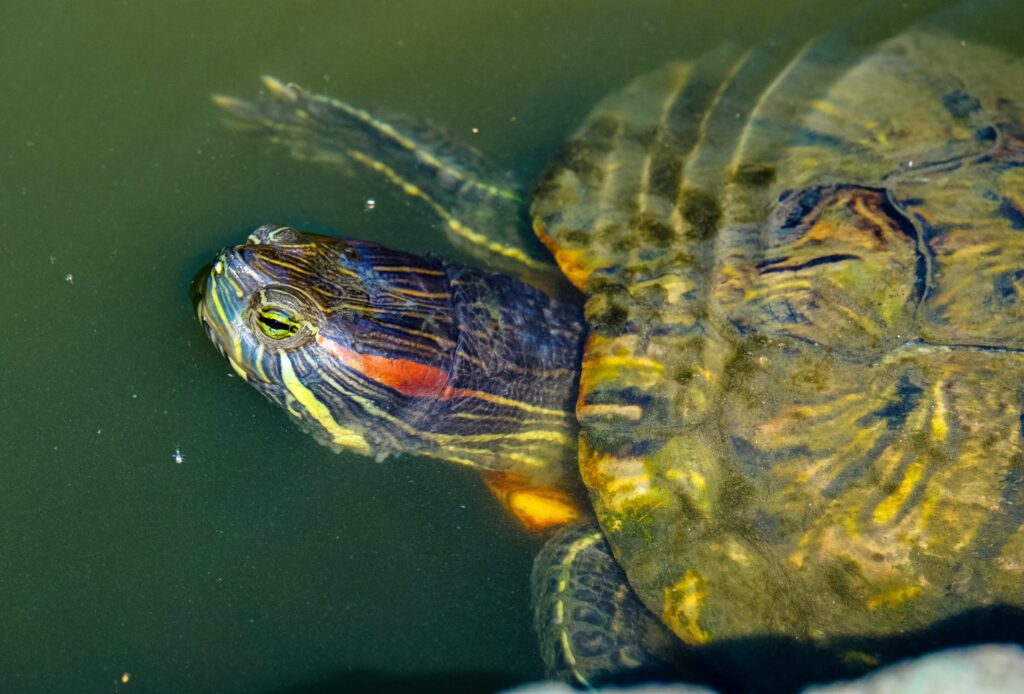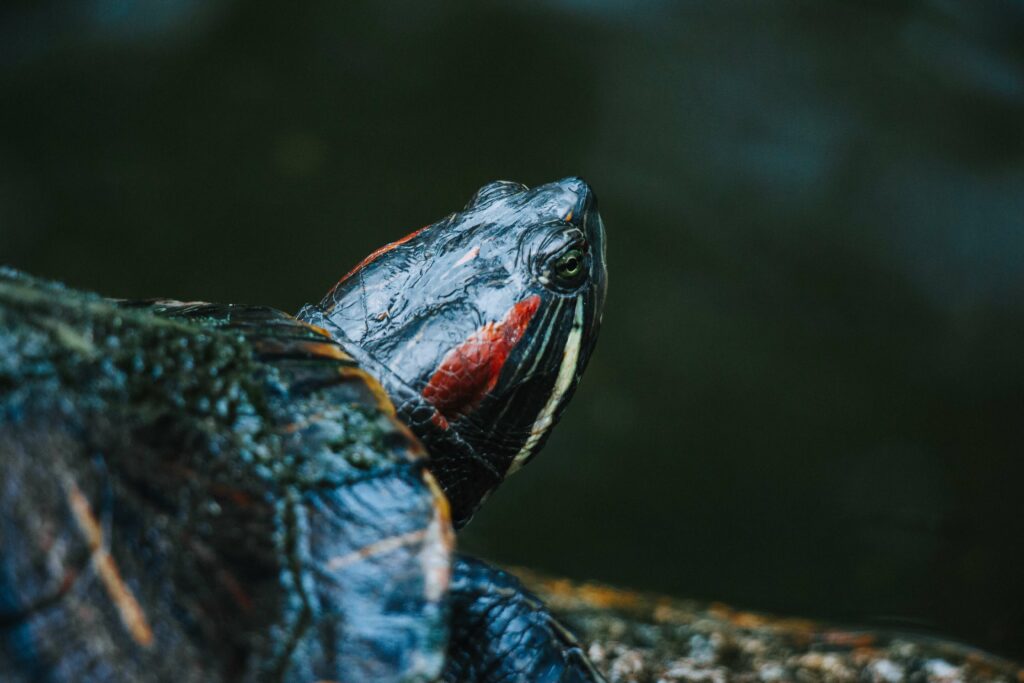In theory, you can keep a turtle in a large goldfish tank, but that arrangement has pros and cons. In reality, most turtle fans state that keeping goldfish and turtles in the same habitat is not a good idea.
In this guide, we discuss why keeping a turtle with goldfish is not generally recommended.
Key Takeaways
- Both need large tanks (10 gallons per inch of turtle) with hiding spots for goldfish to reduce stress.
- Powerful filtration is essential due to high waste from both species.
- Water temperature overlaps (68–75°F), but turtles’ pH needs vary and may clash with goldfish’s preferred pH (~7.4).
- Diets differ greatly, complicating feeding and increasing waste.
- Goldfish need normal lighting; turtles require UVA/UVB and basking areas.
- Outdoor ponds can work if large, heated, well-filtered, with basking spots and secure walls.
- Turtles may eat small or slow goldfish, risking turtle health due to fish bones, fat, and enzymes.
- Goldfish don’t harm turtles directly but their waste harms water quality, risking turtle illness.
- Larger, fast goldfish (Comets, Shubunkins) and some turtles (Red-Eared Sliders) may cohabit cautiously.
- Avoid aggressive turtles (Snapping, Soft-Shelled, Musk) with goldfish.
- Pros: similar temperature and tank basics.
- Cons: turtles eat/nip fish, high waste and maintenance, different diets and lighting, pH issues, need for large space, health risks if turtles eat goldfish.

Can a turtle live in a fish tank?
Although a turtle can live in a goldfish tank, you’ll need to make a few adjustments to your setup to accommodate both species.
Tank size
Turtles need a large tank!
- You will need a big tank with plenty of hiding places for your goldfish.
- Your tank will need a very powerful filter to cope with the amount of waste produced by the fish and the turtle.
As a general rule of thumb, you should allow 10 gallons of water per inch of turtle shell per turtle.
Many of the most popular species of pet turtles, such as red-eared sliders, can grow to measure up to 12 inches long when fully mature. Slim-bodied goldfish species can grow to a similar size, while even Fancy goldfish varieties can reach 8 inches long, so you’ll need a very large tank to accommodate one turtle and a few Comets, Shubunkins, or Fantails.
In a small tank, the goldfish and turtle are more likely to come into conflict, and the water quality will suffer. In addition, you should keep goldfish in groups, as these fish are not suited to a solitary lifestyle. That said, turtles are happy to live alone, and most prefer that arrangement.

Hiding places
If you want to keep goldfish in a turtle tank, you must provide plenty of places where the fish can hide and take refuge from the turtles. In a tank with inadequate hiding spots, the fish will spend their entire time trying to escape from the turtle. That’s extremely stressful for the goldfish and could even eventually result in mortality for the fish.
You could create a separate area for your goldfish that the turtle can’t access. However, that would mean less swimming space for your fish, and that won’t work if you have fast-swimming varieties that need plenty of room to move around.
Filtration Issues
Goldfish are notoriously dirty fish that need a powerful filter system to cope with the quantity of waste they produce. Turtles are also prolific waste producers, requiring a canister filtration system to deal with the mess they make effectively.
It’s not only the waste produced by the turtles that’s a problem in a fish tank. Turtles are messy eaters, dropping bits of food that will quickly rot and contaminate the water if you don’t keep on top of tank maintenance. Although goldfish are scavengers that will eat most things, they generally won’t eat a half-chewed bit of meat that the turtles don’t want!
Water Parameters
Goldfish are coldwater fish that need a temperature of between 68° to 74° F to be happy. Most turtle species appreciate water between 70° to 75° F, so both creatures need water of a similar temperature.
Goldfish and turtles are also both freshwater species, so that’s another common area the two species share.
Regarding pH levels, goldfish like slightly acidic water of around 7.4 pH. If the pH falls below that, the nitrogen cycle begins to falter, and problems arise with the levels of nitrates in the water.
When it comes to turtles, there’s a wide variance in their preferred pH, depending on the species, so you need to research your chosen turtle type carefully to ensure its water parameter requirements are compatible with those of goldfish.
Diet
Both goldfish and turtles are omnivores. Goldfish eat goldfish flakes or pellets, fresh veggies, and frozen meaty proteins, including bloodworms, daphnia, brine shrimp, and the like.
Turtles can be fed processed pet foods like turtle pellets, drained sardines, and trout chow. They also enjoy cooked turkey, beef, and chicken, and you can add variety to the diet by offering your turtles live foods, including shrimp, feeder fish, worms, and crickets.
So, you can see that the two species enjoy radically different diets! That’s going to be expensive and potentially lead to waste, which will impact water quality. In addition, clearing up uneaten food makes more time-consuming work for you.
Lighting
Goldfish need a clear day/night cycle to know when to eat, become active, and rest. A standard LED lighting unit is the best choice for goldfish and works well for your plants, too.
Turtles also need a clear daytime and nighttime light cycle. However, they need UVA and UVB lighting to remain healthy.
Aquatic turtles spend much of their days basking in sunlight in the wild environment. The sun’s warmth raises the turtle’s temperature, helps maintain the animal’s metabolism, and is important for mood, activity, breeding, and feeding.
A basking lamp provides UVA light and simulated daylight for your turtle. UVB night is vital for the production of Vitamin D3, which is essential for healthy bone and shell growth. If you don’t provide proper lighting, your turtle will most likely become sick and die a slow, painful death from bone disease.

Can a turtle live in a pond?

Certain species of turtles can live in a large outdoor pond with goldfish as long as the water is heated. In addition, your pond needs an efficient filtration system to cope with the quantity of waste produced by the turtles and fish.
You’ll need a strong pond liner that can withstand the damage caused by the turtles’ scratching with their sharp claws. A substrate of sand or smooth rocks is a good choice so that the turtles can dig, and aquatic plants add a food source and shelter for the turtles and the goldfish, too.
Areas above the waterline where the turtles can bask are essential, as are deep-water swimming areas. In addition, the pond should be enclosed by a wall of at least 2 feet high to prevent the turtles from escaping and to protect them from predators.
Do turtles eat goldfish?
Turtles are omnivorous creatures, enjoying a diet of meaty protein and plant matter. So, if a goldfish is small enough to fit into the turtle’s mouth, it will be viewed as a food source, and your turtle could easily eat it.
Fancy goldfish are slow, clumsy swimmers that a predatory turtle could easily catch, although fully-grown slim-bodied goldfish are usually too large and fast to be in danger. Even if your turtle doesn’t eat the goldfish, there’s a strong likelihood that the fish will be nipped, injured, and stressed by the turtle.
If your turtle does eat your goldfish, the fish’s tiny bones could damage the turtle’s throat and intestinal tract, and the high volume of fat the fish contains can lead to vitamin E deficiency for the turtle. Vitamin E deficiency in turtles causes a disease called steatitis that can lead to a weakened shell and bones, eye infections, and slow healing of injuries.
In addition, goldfish contain an enzyme called thiaminase that destroys the vitamin B1 in the aquatic turtle’s diet. If a turtle ingests thiaminase, respiratory failure and death can result. In fact, that’s the most common cause of unexplained deaths in freshwater turtles.
In fact, that’s why turtle keepers don’t generally use feeder goldfish as a food source for their turtles.

Do goldfish harm turtles?
Although goldfish are peaceful creatures that won’t directly attack or bother your turtle, they produce lots of waste, which can cause high ammonia, nitrite, nitrate levels, and pH fluctuations.
Those conditions lead to health issues for the turtle, including internal bleeding, liver damage, cancer, and respiratory infections. In severe cases, your turtle could even die.
What type of goldfish can live with a turtle?

Some hobbyists have reported that keeping certain goldfish species, such as Comets, Shubunkins, Orandas, and Wakins, works since these fish grow much larger than most aquatic pet turtle species.
As previously mentioned, the slim-bodied goldfish varieties are powerful swimmers that can easily keep clear of the turtles.
However, when all’s said and done, I don’t recommend keeping turtles and goldfish together, as the turtle will typically see your goldfish as nothing more than food.

What turtle species can live with goldfish?
There are lots of different aquatic turtles to choose from, all with different behaviors and characteristics, and some are more aggressive than others.
Generally, Red-Eared Sliders, Peninsular Cooters, and Northern Red-Bellied turtles are the most compatible with goldfish in ponds and tanks. Incompatible turtle species that should never be kept with goldfish include Soft-Shelled turtles, Snapping turtles, and Musk turtles, all of which have a reputation for biting and belligerence.
Many hobbyists report that adding turtles to an established goldfish setup can make it less likely that the goldfish will be attacked or eaten. However, there’s no scientific evidence to prove or refute that, so we can’t be certain that it’s accurate.
Pros and cons of keeping turtles and goldfish together
There are advantages and disadvantages to keeping goldfish and turtles together. Let’s take a look at them!
Pros
- Goldfish and turtles share similar water temperature requirements.
- Turtles and goldfish like a similar tank size and setup.
Cons
- Large turtles eat small goldfish and tend to nip at them.
- Both species produce lots of waste, so keeping on top of water quality is time-consuming and requires a powerful filtration system.
- Both species eat somewhat different diets, potentially leading to waste, mess, and expense.
- The correct pH level is essential for your turtle’s health, but most turtle species need a different pH than that of goldfish.
- Turtles and goldfish can grow pretty large, so you’ll need a big tank or pond to accommodate them. In addition, turtles need a terrestrial basking area with suitable lighting, making the size of the required environment size even larger.
- As mentioned earlier in this guide, if eaten, goldfish can cause certain vitamin deficiencies and other health problems for your turtles.
- Turtles can be highly sensitive to poor water quality. Goldfish produce lots of waste that can cause increases in ammonia and nitrate levels in the water, as well as pH changes, which means serious health problems for your turtles.
I can vouch for the high level of maintenance a goldfish tank needs! You can multiply that tenfold if you add turtles to the mix since they produce masses of waste and are messy eaters.
Final Thoughts
Did you enjoy our guide to keeping goldfish and turtles together? If you did, please share the article!
Turtles and goldfish can make excellent pets for adults and kids! Goldfish and turtles can live in ponds and tanks, sharing the same water temperature requirements and basic setup. But that’s where their compatibility ends.
Turtles will view goldfish as a food source and could hassle and nip at the fish. If your turtle succeeds in eating your goldfish, that can result in serious health problems for the turtle. Both species produce a lot of waste and mess that necessitates a serious filtration system to cope, and their diet and lighting requirements are quite different.
The list of cons to keeping goldfish with turtles is long, and we don’t recommend the two species as tank mates. But do you have turtles and goldfish? Are they kept in a pond or tank?
FAQ
Q: Can turtles live in a goldfish tank?
A: Yes, but only if the tank is very large, well-filtered, and has plenty of hiding places for the goldfish. Still, it’s generally not recommended.
Q: Will turtles eat goldfish?
A: Turtles are omnivores and may eat small or slow goldfish. Even if not eaten, turtles may nip and stress goldfish.
Q: Can goldfish harm turtles?
A: Goldfish don’t attack turtles, but their waste can degrade water quality, potentially causing health issues for turtles.
Q: What size tank do I need for turtles and goldfish?
A: At least 10 gallons per inch of turtle shell, plus enough space for multiple goldfish to swim comfortably.
Q: Do turtles and goldfish need the same water conditions?
A: Their preferred temperatures overlap (around 68-75°F), but pH and other parameters can vary depending on turtle species.
Q: What lighting do turtles and goldfish need?
A: Goldfish require a normal day/night light cycle, while turtles need UVA/UVB lighting and basking areas for health.
Q: Are there any turtle species better suited to live with goldfish?
A: Red-Eared Sliders, Peninsular Cooters, and Northern Red-Bellied turtles are more compatible; aggressive turtles like snapping or soft-shelled turtles are not.
Q: Can turtles and goldfish share an outdoor pond?
A: Yes, if the pond is large, heated, filtered, has proper shelter, basking spots, and barriers to keep turtles contained and safe.
Q: What are the main cons of keeping turtles and goldfish together?
A: Predation risk, dietary incompatibility, high waste production, difficult water maintenance, and differing lighting needs.
Tell us how you make the arrangement work in the comments box below!
